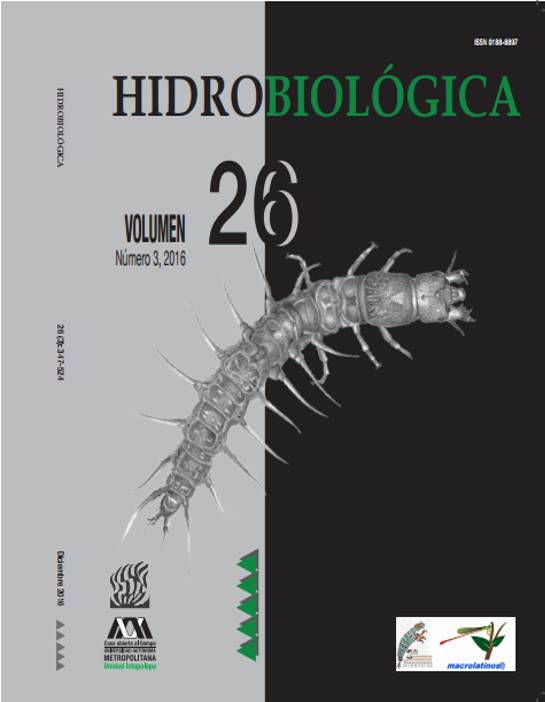Composition and distribution of aquatic insects in streams of Tabasco, Mexico
DOI:
https://doi.org/10.24275/uam/izt/dcbs/hidro/2016v26n3/BarbaMKeywords:
Aquatic-insects, diversity, ecology, entomofauna, reophil-organism, streamsAbstract
Background. Aquatic systems of Tabasco have been affected by various anthropogenic activities (Bueno-Soria, et al., 2005), however the knowledge of the aquatic insects is emerging, so it is important to know your current status in the state. Goals. To determine the distribution, abundance and diversity of aquatic insect fauna in streams of Tabasco. Methods. Samples were conducted at 38 locations during the years 2010 to 2013 in daytime and multihabitat effort. Results. Environmental variables as temperature, dissolved oxygen, conductivity and salinity showed significant differences between municipalities with p= 0.006. Principal component analysis ordination by municipalities showed 60% of the total variance explained by conductivity and dissolved oxygen for the first axis and the depth and the pH for the second factor. A total of 5,315 individuals, belonging to 11 orders and 56 families were collected. The highest diversity was recorded in Tacotalpa, Tenosique and Huimanguillo with H=2.87; H=1.09 and H=0.5, and richness were 42, 29 and 25 families respectively, and minimal richens was in Cardenas with six families. Tacotalpa and Tenosique represents 78% of the total density. In Tacotalpa dominated: Phylopotamidae, Chironomidae and Caenidae; Tenosique, Caenidae, Chironomidae and Coenagrionidae. While in Cardenas were Baetidae and Notonectidae. Conclusions. Highest riparian vegetation coberture presented in municipalities of Tacotalpa, Tenosique and Huimanguillo regulates insect composition. However the composition and structure of aquatic insects depends on multiple biotic and abiotic variables.Downloads
Downloads
How to Cite
Issue
Section
License
Los autores/as que publiquen en esta revista aceptan las siguientes condiciones:
De acuerdo con la legislación de derechos de autor, HIDROBIOLÓGICA reconoce y respeta el derecho moral de los autores, así como la titularidad del derecho patrimonial, el cual será cedido a la revista para su difusión en acceso abierto.
Publicar en la revista HIDROBIOLÓGICA tiene un costo de recuperación de $500 pesos mexicanos por página en blanco y negro (aproximadamente 29 dólares americanos) y $1000 pesos por página a color (aproximadamente 58 dólares americanos).
Todos los textos publicados por HIDROBIOLÓGICA sin excepción se distribuyen amparados bajo la licencia Creative Commons 4.0Atribución-No Comercial (CC BY-NC 4.0 Internacional), que permite a terceros utilizar lo publicado siempre que mencionen la autoría del trabajo y a la primera publicación en esta revista.
Los autores/as pueden realizar otros acuerdos contractuales independientes y adicionales para la distribución no exclusiva de la versión del artículo publicado en HIDROBIOLÓGICA (por ejemplo incluirlo en un repositorio institucional o publicarlo en un libro) siempre que indiquen claramente que el trabajo se publicó por primera vez en HIDROBIOLÓGICA.
Para todo lo anterior, el o los autor(es) deben remitir el formato de Carta-Cesión de la Propiedad de los Derechos de la primera publicación debidamente requisitado y firmado por el autor(es). Este formato se puede enviar por correo electrónico en archivo pdf al correo: enlacerebvistahidrobiológica@gmail.com; rehb@xanum.uam.mx (Carta-Cesión de Propiedad de Derechos de Autor).
Esta obra está bajo una licencia de Creative Commons Reconocimiento-No Comercial 4.0 Internacional.


